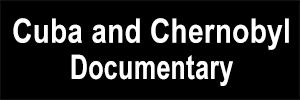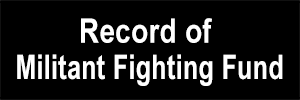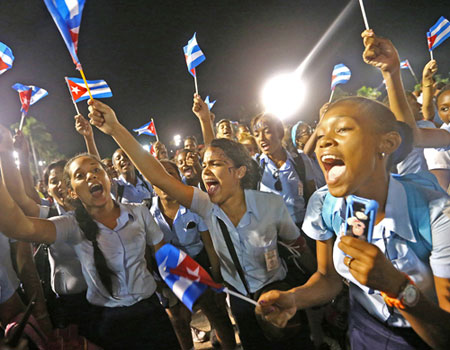Remarks by Army Gen. Raúl Castro Ruz, first secretary of the Central Committee of the Communist Party of Cuba and president of the Councils of State and Ministers, during the tribute to the commander in chief of the Cuban Revolution, Fidel Castro Ruz, held in Santiago de Cuba’s General Antonio Maceo Grajales Square, Dec. 3, 2016, “Year 58 of the Revolution.” Translation is by the Militant.
Esteemed heads of state and government; outstanding figures who join us today; fellow Cubans representing the eastern provinces and Camagüey; people of Santiago de Cuba; dear people of Cuba:
This afternoon, when the funeral procession carrying Fidel’s ashes — which retraced in reverse the route of the January 1959 Freedom Caravan — arrived in this heroic city, it passed several historic landmarks in Santiago de Cuba, cradle of the revolution. And here, just as in the rest of the country, it was met with demonstrations of love by the Cuban people.
Fidel’s ashes will be laid to rest tomorrow in a simple ceremony in the Santa Ifigenia Cemetery, close to the Mausoleum of National Hero José Martí1 as well as to the resting place of his comrades in arms at Moncada,2 on the Granma expedition3 and the Rebel Army and the urban underground, and on our internationalist missions.
Just a few steps from here are the tombs of Carlos Manuel de Céspedes, father of the homeland, and the legendary Mariana Grajales, mother of the Maceo4 brothers and — improvising here, I dare to say — also the mother of all Cuban men and women.
Also close by is the pantheon holding the remains of the unforgettable Frank País García — a young man from Santiago, murdered by the Batista tyranny’s henchmen when he was only 22 years old, one month after his younger brother, Josué, died fighting in an action here.
Frank’s age didn’t stop him from accumulating an exemplary experience of resistance against the dictatorship. He stood out as leader of the Nov. 30, 1956, armed uprising in Santiago de Cuba, in support of the landing of the Granma expedition, and for his role in organizing the crucial sending of weapons and combatants to the nascent Rebel Army in the Sierra Maestra.
Ever since the news of the death of the historic leader of the Cuban Revolution, in the late evening of Nov. 25, pain and sadness have overwhelmed the Cuban people. Deeply moved by his irreparable physical disappearance, they have shown integrity, patriotic conviction, discipline and maturity as they have joined events in tribute to Fidel in massive numbers and committed themselves to the pledge of loyalty to the concept of revolution Fidel outlined May 1, 2000. On Nov. 28 and 29, millions of compatriots signed their names in support of the revolution. [The pledge was printed in last week’s Militant.]
Amid the pain of these days we have once again felt pride and comfort in the impressive response by Cuban children and youth, who reaffirm that they are prepared to continue to uphold loyally the ideals of the leader of the revolution.
On behalf of our people, party, state, and government and of the family members, I offer again our most heartfelt thanks for the countless displays of respect and affection toward Fidel, his ideas and his work, which continue to arrive from the four corners of the world.
Faithful to Martí’s view that “all the glory of the world fits in a kernel of corn,” the leader of the revolution rejected any expression of a cult of personality. He remained true to this position through the final hours of his life. He insisted that after he died, his name and likeness never be used to designate institutions, plazas, parks, avenues, streets, or any other public spaces. And that no monuments, busts, statues or other forms of tribute be erected in his memory.
In accordance with compañero Fidel’s decision, we will introduce the necessary legislation at the next session of the National Assembly of People’s Power to ensure his wishes are carried out.
Our dear friend [Abdelaziz] Bouteflika, president of Algeria, rightly said that Fidel possessed the extraordinary ability to travel into the future, return and explain it. On July 26, 1989, in the city of Camagüey, the commander in chief predicted — two and a half years in advance — the disappearance of the Soviet Union and the socialist camp. And he stated there before the world that if this were to happen, Cuba would continue to defend the banner of socialism.
Fidel’s authority and his close relationship with the people were decisive to the country’s heroic resistance during the dramatic years of the Special Period — when our gross domestic product fell 34.8 percent, the Cuban people’s nutrition deteriorated significantly, we suffered blackouts lasting 16 to 20 hours a day, and much of our industry and public transport was paralyzed. Despite this, however, we were able to safeguard public health and education for the entire population.
I recall the party meetings held in July 1994 in different regions — in Holguín in the east; in Santa Clara in the central region; and in Havana, the capital, in the west. We discussed how to confront, with greater efficiency and cohesion, the challenges of the Special Period, the tightening imperialist blockade and the media campaigns aimed at sowing discouragement among our citizens.
We left these meetings, including the one led by Fidel in the western region, convinced that with the strength and intelligence of the masses brought together under the leadership of the party, we could transform the Special Period into a new, victorious battle in the country’s history. And that’s what we did.
At the time, few in the world thought we could resist and overcome in face of adversity and the enemy’s intensified encirclement. Nevertheless, under Fidel’s leadership our people gave an unforgettable lesson in tenacity and loyalty to the principles of the revolution.
Recalling these difficult moments, I think it’s right and fitting to return to what I said about Fidel more than 22 years ago, on July 26, 1994 — one of the most difficult years — on the Isle of Youth.
I quote, “The most visionary son of Cuba this century, the one who showed us that yes, the attempt to capture the Moncada garrison was possible; that yes, that setback could be turned into a victory.” And we achieved that victory five years, five months and five days later, on that glorious Jan. 1, 1959. This last comment I have added to the words I spoke on that occasion. (Applause).
He showed us, “that yes, we could reach the coast of Cuba on the Granma yacht. Yes, we could resist the enemy, hunger, rain and cold, and organize a revolutionary army in the Sierra Maestra mountains following the debacle at Alegría de Pío.5
“That yes, we could open new guerrilla fronts in the province of Oriente, [Juan] Almeida’s column and ours.
“That yes, with 300 rifles we could defeat the great offensive by more than 10,000 soldiers,” a victory that, as Che [Guevara] wrote later in his campaign diary, broke the back of the dictatorship’s army.
“That yes, we could repeat the feats of Maceo and [Máximo] Gómez, extending the struggle from the east to the west of the island with Che and Camilo [Cienfuegos]’s columns.
“That yes, with the support of the entire people we could defeat the Batista tyranny backed by U.S. imperialism.
“He showed us that yes, we could defeat in 72 hours,” or even less, “the mercenary invasion of Playa Girón and simultaneously continue the campaign to eradicate illiteracy within a year,” which is what we accomplished in 1961.
“That yes, we could proclaim the socialist character of the revolution 90 miles from the empire, and do that as its warships advanced toward Cuba, backing the brigade of mercenary troops.
“That yes, we could resolutely uphold the inalienable principles of our sovereignty, without fearing the threat of nuclear blackmail by the United States during the October 1962 missile crisis.
“That yes, we could send aid and solidarity to our sister peoples struggling against colonial oppression, foreign aggression and racism.
“That yes, we could defeat the South African racists, defending Angola’s territorial integrity, forcing Namibia’s independence and delivering a harsh blow to the apartheid regime.
“That yes, we could turn Cuba into a powerhouse in the medical field, and reduce infant mortality — first to the lowest rate in the Third World, and then as compared with the world of rich countries. On this continent, for example, Cuba’s rate of mortality for children under one year of age is lower than that of Canada and United States itself. (Applause) And at the same time, we have significantly increased the life expectancy of our people.
“He showed that yes, we could transform Cuba into a great center of science. Advance in the modern, decisive fields of genetic engineering and biotechnology. Break into the exclusive domain of the international pharmaceutical industry. Develop tourism despite the U.S. blockade. Build causeways in the sea to make Cuba more attractive and increase hard-currency income from our natural beauty.
“That yes, we can resist, survive and develop without renouncing our principles or the achievements of socialism. And do so in the unipolar world, dominated by the multinational corporations, that emerged after the fall of the socialist camp in Europe and the disintegration of the Soviet Union.
“Fidel’s enduring lesson is that yes we can, that humans are capable of overcoming the harshest conditions — if their willingness to overcome does not falter, if they accurately assess every situation and don’t give up their just and noble principles.”
These are the words that I spoke more than two decades ago about a man who, after the initial disastrous battle at Alegría de Pío — the day after tomorrow will be its 60th anniversary — never lost faith in victory, and 13 days later on Dec. 18 that same year, now in the mountains of the Sierra Maestra, having assembled seven rifles and a handful of combatants, said: “Now we will win the war!” (Applause and shouts of “Fidel, Fidel! That’s Fidel!”)
This is the undefeated Fidel who brings us together through his example and demonstration that, yes we could, yes we can, and yes we will! (Applause and shouts of “Yes we can!”) I repeat, he demonstrated that yes we could, yes we can, and yes we will overcome any obstacle, threat or turmoil in our determined efforts to build socialism in Cuba. Or to say it another way, which is the same thing: To guarantee the independence and sovereignty of our homeland! (Applause)
Before Fidel’s remains in the General Antonio Maceo Grajales Revolutionary Square, in the heroic city of Santiago de Cuba, we pledge to defend the homeland and socialism! (Shouts of “We pledge!”)
Together we all reaffirm the vow of the Bronze Titan: “Whoever attempts to conquer Cuba will gain nothing but the dust of her blood-soaked soil — if they do not perish in the struggle!” (Shouts)
Fidel, Fidel! ¡Hasta la Victoria! (Shouts of “¡Siempre! Onward!”)
1 José Martí was a lifelong combatant for Cuban independence. He founded the Cuban Revolutionary Party in 1892 to fight Spanish colonial rule and frustrate U.S. designs on Cuba. He was killed in battle in 1895 war.
2 On July 26, 1953, some 160 revolutionaries under the command of Fidel Castro attacked the Moncada army headquarters in Santiago de Cuba hoping to begin an insurrection against the Batista dictatorship. After the attack failed, Batista’s forces massacred more than 50 of the captured revolutionaries and imprisoned Castro.
3 Granma was the name of the yacht used by the revolutionaries to travel from Mexico to Cuba in 1956 to launch the struggle that overthrew Batista in 1959.
4 Antonio Maceo was a central military leader in Cuba’s 1868-78, 1879-80 and 1895-98 wars of independence. Like his three brothers and his father, he died in battle against the Spanish occupation.
5 Rebel combatants who had landed with the Granma were surprised by Batista’s troops at Alegría de Pío on Dec. 5, 1956, and dispersed under heavy fire. Half the rebels were murdered or imprisoned. Thirteen days later eight of the survivors rebels, including Fidel and Raúl, made it to the Sierra Maestra.
Related articles:
Millions line streets across Cuba for Freedom Caravan
|
Printer-friendly version of this article |








 click here for information and literature from the Socialist Workers Party 2016 campaign
click here for information and literature from the Socialist Workers Party 2016 campaign a magazine of Marxist politics and theory from 1934 to the present
a magazine of Marxist politics and theory from 1934 to the present an international news magazine published from 1963 to 1986
an international news magazine published from 1963 to 1986 issues of the monthly Spanish-language socialist magazine from 1999 to 2005
issues of the monthly Spanish-language socialist magazine from 1999 to 2005




